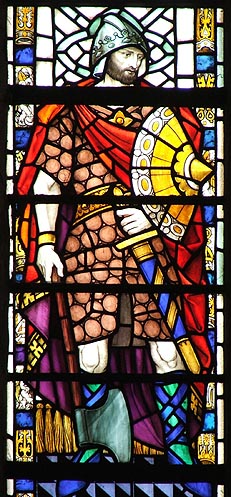 |
 |
|||
|
|
 Aethelstan,
King of the English Aethelstan,
King of the English(AD 895-939) Aethelstan was the eldest, but illegitimate, son of King Edward the Elder, born to his common-law wife, Egwina, in AD 895. When he was only four years old, his father took himself a wife and Aethelstan was sent away to be brought up by his aunt, Aethelflaed, the powerful Lady of the Mercians, at the Royal courts of Tamworth and Gloucester. The circumstances surrounding the Royal succession upon the death of Aethelstan's father, in July AD 924, are shrouded in confusion. Aethelflaed had died some years before, and it appears that Edward may have intended his kingdom to be divided between Aethelstan in Mercia and his eldest legitimate son, Aelfweard, in Wessex. Alternatively, when Aelfweard succeeded, the Mercians may simply have rejected him. There was certainly tension between the two, which ended up with Aelfweard's mysterious death only two weeks later. Aethelstan was now King of all England, but he faced further opposition from an otherwise unknown prince named Alfred. Possibly he was a grandson of King Aethelred I. Eventually however, Aethelstan was secure enough to hold his coronation ceremony, and he was crowned at Kingston in the September of the following year. Aethelstan soon set about consolidating his position in England. He signed an alliance treaty with King Sigtrygg of York in AD 926, but this unfortunately collapsed upon the latter's death the following year. Aethelstan was forced to move north to re-assert his influence over, if not his control of, Norse York. His mighty army swept across York and Northumbria, expelling the new king, Olaf Sigtryggson. At Eamont, Aethelstan received the submission of High-Reeve Eldred I of Bamburgh and Kings Constantine II of the Scots and Owen of Strathclyde; and a peace treaty - the Treaty of Penrith - was signed with the Scottish monarchs ending the aggression of the past decade. Around the same time, Kings Hywel Dda of Deheubarth and Owain of Glywysing & Gwent felt it wise to submit to Aethelstan's overlordship at Hereford; and the border between England and Wales was formerly set at the River Wye. The Welsh rulers, this time including the Gwynedd king, re-attested their loyalty by attending Aethelstan at the English court, four years later. They were later followed by King Tewdr of Brycheiniog. Despite becoming one of the most powerful monarchs Britain had ever seen, it seems that the Wessex party were still not happy with Aethelstan's leadership. They apparently plotted to have him blinded at Winchester and replaced by the late Aethelweard's full-brother, Edwin. Whether the plot simply failed or was uncovered is not clear, but in AD 933, the men of Wessex seem to have broken out into open rebellion for there was "disturbance in the kingdom". Aethelstan's forces managed to drive Edwin abroad, but he died in a storm at sea. It has been suggested that, after this event, Aethelstan deliberately refrained from acquiring a direct heir to his kingdom, so that the two parties would reconcile after his death. Perhaps Constantine II of the Scots saw this chink which wessex opened in Aethelred's armour. For, the following year, he broke their seven-year peace and attacked England. Aethelstan moved quickly and led a vast land and sea campaign into Scotland, whilst compelling his Welsh sub-Kings to help swell his army's numbers. They ravaged the northern kingdom as far as Dunottar (near Aberdeen), while the naval force sailed to Caithness! In AD 937, Constantine retaliated by forming a powerful alliance with the British subjects of King Owen of Strathclyde and the Norse warriors of King Olaf Guthfrithson of Dublin. A great invasion army marched south, but Aethelstan was ready for them and the Northerners were soundly defeated at the Battle of Brunanburgh. Aethelstan was now effect overlord of all Britain and he even claimed such a title on his coinage and in his Royal charters. The latter throw much light on the organization of Aethelstan's Royal government. Between AD 928 and 935, his charters were written by a single man, perhaps a royal scribe. Seven of his lawcodes also survive. Four were officially drawn up for the King himself: one a proclamation from Grately and another from Exeter. It is not surprising that foreign scholars flocked to such a highly ordered Royal Court: amonst them, the Irish, Bretons, Franks, Germans and Italians. Notable individuals included the Icelander, Egill Skallagrimsson, and Israel the Grammarian. King Aethelstan had even more European contacts than his grandfather, Alfred the Great. He married off four of his half-sisters to noble continental families, including a German Emperor and a Frankish King. When the latter, Charles the Simple, was imprisoned by his enemies, his wife, Edith, brought their son and heir, Prince Louis, to England. Like Duke Alan of Brittany and Prince Haakon of Norway, he was fostered at Aethelstan's Royal Court. Aethelstan was a religious man who patronised a number of Wessex monasteries. He founded Muchelney Abbey in Somerset, for example. His generosity to the Church was well-known, not just in terms of money, but books and other holy treasures. Aethelstan was also an enthusiastic relic collector and sent out agents across Europe to acquire them. Milton Abbey in Dorset was especially pleased with his gift of St. Samson's arm and St. Branwaladr's head which made it into an important pilgrimage centre. He died on 27th October AD 939 and was buried, not in the family mausoleum in Winchester, but at his favourite abbey at Malmesbury. A medieval tomb bearing his effigy can still be seen there today. Aethelstan was succeeded by his half-brother, Edmund. Click for More Images of King Aethelstan
|
|||
| © Nash Ford Publishing 2003. All Rights Reserved. | ||||


